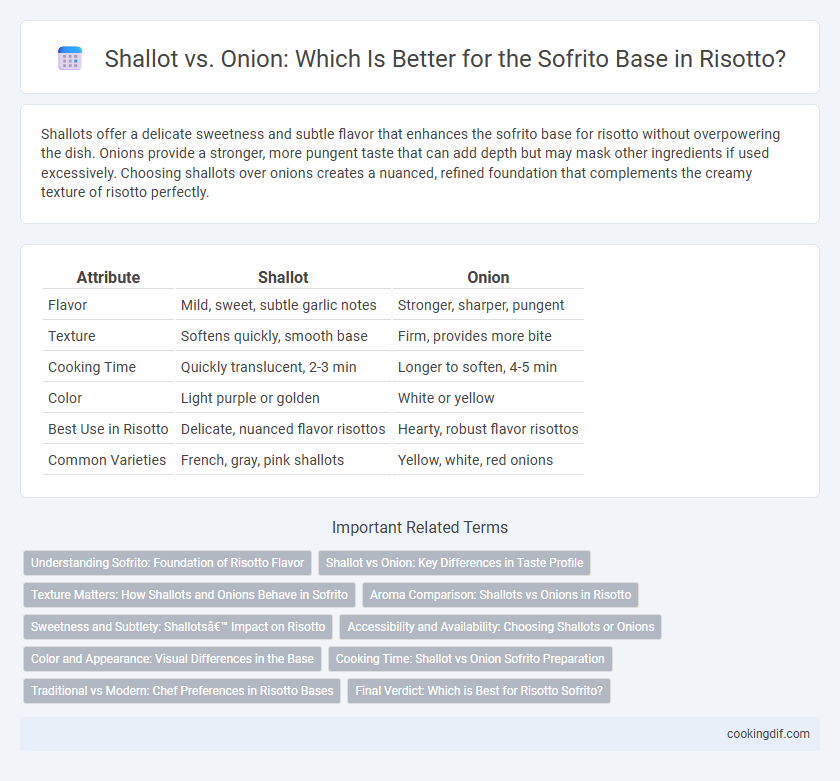Shallots offer a delicate sweetness and subtle flavor that enhances the sofrito base for risotto without overpowering the dish. Onions provide a stronger, more pungent taste that can add depth but may mask other ingredients if used excessively. Choosing shallots over onions creates a nuanced, refined foundation that complements the creamy texture of risotto perfectly.
Table of Comparison
| Attribute | Shallot | Onion |
|---|---|---|
| Flavor | Mild, sweet, subtle garlic notes | Stronger, sharper, pungent |
| Texture | Softens quickly, smooth base | Firm, provides more bite |
| Cooking Time | Quickly translucent, 2-3 min | Longer to soften, 4-5 min |
| Color | Light purple or golden | White or yellow |
| Best Use in Risotto | Delicate, nuanced flavor risottos | Hearty, robust flavor risottos |
| Common Varieties | French, gray, pink shallots | Yellow, white, red onions |
Understanding Sofrito: Foundation of Risotto Flavor
Shallots provide a delicate sweetness and subtle complexity that enhances the sofrito base for risotto, offering a refined aroma without overpowering the dish's flavor profile. Onions, particularly white or yellow varieties, contribute a more robust and pungent taste that helps build a strong, savory foundation in the sofrito. Choosing shallots or onions for sofrito influences the risotto's depth, with shallots favoring nuanced elegance and onions delivering pronounced savory richness.
Shallot vs Onion: Key Differences in Taste Profile
Shallots offer a mild, subtly sweet flavor with a hint of garlic, making them ideal for a delicate risotto base, while onions provide a stronger, more pungent taste that can overpower the dish. The finer texture of shallots blends smoothly into the sofrito, enhancing the risotto's creamy consistency without adding sharpness. Using shallots instead of onions results in a softer, more nuanced aromatic foundation, perfect for highlighting delicate ingredients like seafood or mushrooms in risotto.
Texture Matters: How Shallots and Onions Behave in Sofrito
Shallots offer a finer, silkier texture than onions, creating a smoother sofrito base that gently melds into risotto without overpowering it. Onions provide a firmer bite and more pronounced structure, adding subtle layers of texture to the dish's foundation. Choosing shallots enhances creaminess, while onions contribute a slight crunch, both crucial for achieving the perfect risotto mouthfeel.
Aroma Comparison: Shallots vs Onions in Risotto
Shallots impart a delicate, sweet aroma with subtle garlic undertones, enhancing the risotto's flavor complexity without overpowering the dish. Onions offer a more robust, pungent scent that intensifies during sauteing, creating a heartier, earthier base for the sofrito. Choosing shallots over onions in risotto results in a refined, nuanced aroma that complements the creamy texture and delicate ingredients.
Sweetness and Subtlety: Shallots’ Impact on Risotto
Shallots enhance risotto with their natural sweetness and delicate flavor, creating a more nuanced sofrito base compared to onions. Their subtle aromatic profile melds seamlessly into the rice, allowing other ingredients like Parmesan and white wine to shine without overpowering the dish. Using shallots instead of onions results in a sophisticated risotto with a gentle, balanced sweetness that elevates overall taste complexity.
Accessibility and Availability: Choosing Shallots or Onions
Shallots offer a milder, slightly sweeter flavor ideal for delicate risotto sofrito bases but may be less accessible and more expensive in some regions compared to onions. Onions, widely available and affordable year-round, provide a robust and savory foundation that enhances the umami depth of risotto dishes. Selecting between shallots and onions depends on balancing flavor preferences with ingredient accessibility and budget considerations for consistent risotto preparation.
Color and Appearance: Visual Differences in the Base
Shallots create a softer, more translucent base with a pale golden hue, enhancing risotto's delicate appearance, while onions tend to produce a more robust, opaque mixture with a deeper yellow-brown color. The choice between shallot and onion affects not only flavor but also the visual appeal of the sofrito layer, influencing the final presentation of the dish. Shallots contribute a refined, subtle tone ideal for light risottos, whereas onions provide a heartier, richer color suited to rustic recipes.
Cooking Time: Shallot vs Onion Sofrito Preparation
Shallots soften more quickly than onions, reducing sofrito base cooking time in risotto preparation. Their delicate texture allows them to caramelize faster, enhancing flavor development without prolonged sauteing. Onions require longer cooking to achieve the same translucency and depth, which can extend overall risotto prep time.
Traditional vs Modern: Chef Preferences in Risotto Bases
Shallots offer a delicate sweetness and subtle flavor that many traditional chefs prefer for risotto sofrito bases, preserving the dish's classic Italian roots. Modern chefs often opt for onions due to their stronger taste and broader availability, which can add a more robust depth to the risotto. Both choices influence the final texture and aroma, with shallots creating a smoother, refined base and onions providing a heartier, more pronounced foundation.
Final Verdict: Which is Best for Risotto Sofrito?
Shallots offer a milder, sweeter flavor that enhances risotto sofrito by adding subtle complexity without overpowering the dish, making them ideal for delicate risotto recipes. Onions provide a stronger, more pungent taste that creates a robust base, perfect for hearty or rustic risotto variations. The final verdict depends on the desired flavor profile: choose shallots for elegance and balance, or onions for depth and intensity in risotto sofrito.
Shallot vs Onion for sofrito base Infographic

 cookingdif.com
cookingdif.com